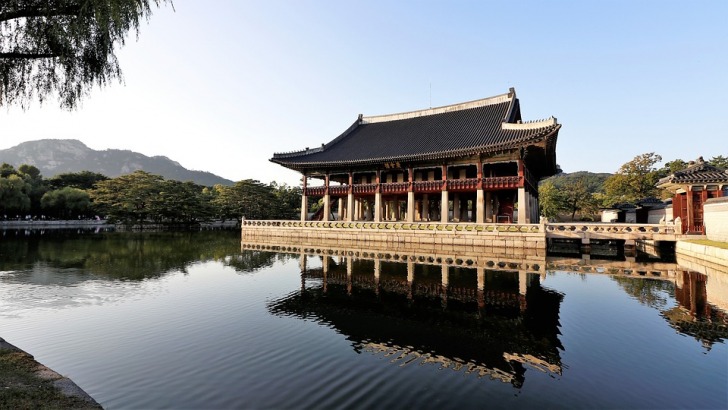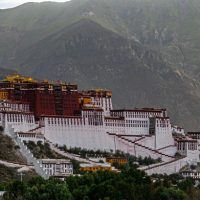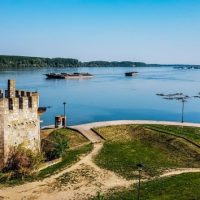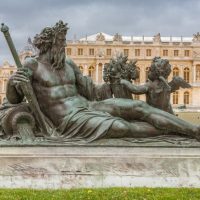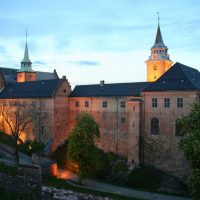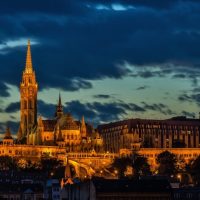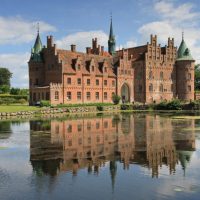South Korea spans 38502.11 square miles in area, making it a bit smaller than Pennsylvania but a little larger than Indiana.
The word gungjeong means palace in Korean, which refers to the five royal palaces of Seoul.
On the other hand, seong means fortress or castle, which describes the over 2400 mountain fortresses throughout the country.
For example, UNESCO counts 212 mountain fortresses in Chungcheongbuk-do alone, the central province in South Korea.
All have their unique form of beauty, designed to protect the royal household and the people of the surrounding domain.
Contents
- Most Beautiful Castles in South Korea
- South Korea Safety Overview
- Frequently Asked Questions
- How large is South Korea?
- What are the biggest threats to Hwaseong Fortress?
- When was Geumjeongsanseong Fortress erected?
- Who ordered the building of the Gyeonghuigung Palace?
- What did Changgyeonggung Palace become after the Japanese takeover?
- What does Deoksugung mean?
- How many Royal Palaces exist in South Korea versus the number of fortresses?
- Why is Biwon, the Secret Garden of Changdeokgung Palace, so ecologically important?
- What design principles did Master Doseon use to build Changdeokgung Palace?
- Why did civil engineers build the stream named Cheonggyecheon (청계천)?
- When did King Taejo build Gyeongbokgung Palace, whose name means Brilliant Fortune?
Most Beautiful Castles in South Korea
Gyeongbokgung Palace | 경복궁
In 1395, King Taejo (태조), who founded the Joseon Dynasty, built Gyeongbokgung Palace to house the royal family and serve as the center of government.
The castle’s name means Brilliant Fortune, expressing the king’s desire for his dynasty to prosper.
In 1592, during the Imjin War (임진왜란), the Japanese destroyed the castle.
In 1867, 270 years later, restoration began, but Japanese spies assassinated Empress Myeongseong (명성) in 1895.
Subsequently, the family abandoned the palace and never returned.
During another occupation in the early 1900s, the Japanese destroyed the new court.
Among the features of the Gyeongbokgung Palace is the Gyeonghoeru (경회루) Pavilion, built by King Taejong (태종), the fifth son of King Taejo, in 1412.
An artificial pond surrounded the rectangular wooden structure, which had 48 stone pillars supporting the square pillars along the outer edges of the pavilion and the round columns holding up the inner frame.
Japanese occupation forces destroyed Gwanghwamun (광화문), the main gate of Gyeongbokgung.
In 1968, during the administration of Park Chung Hee (박정희), the South Korean government tried to restore the gate, replacing it with a concrete structure.
However, not until 2010 did they replace the gate with its original wooden construction.
Civil engineers built Cheonggyecheon (청계천), a stream, during the Joseon era to provide a drainage system.
The stream’s original name, Gaecheon (개천), means Opening of Heaven.
The stream served the area until after the Korean War when a highway eventually covered it.
At the beginning of the new millennium in 2003, the government restored the stream to return Seoul to a more natural and environmentally friendly status.
Changdeokgung Palace | 창덕궁
King Taejong ordered the construction of Changdeokgung Palace on a 143-acre site favorable to the family’s future: at the base of the Ungbong Peak of the guardian mountain, Mount Baegaksan.
Using principles of bibo-pungsu-jiri, Korea’s version of feng shui, a Buddhist monk named Master Doseon designed the palace and its outbuildings to harmonize with the landscape.
With three courts: one for administration, one for the royal residence, and one for holding audiences, the buildings had hipped roofs covered in tile, with ornate, carved decorative corbels: a type of bracket designed for its aesthetic rather than practicality.
Biwon, the Secret Garden set to the north of the palace, holds more than 56,000 specimens of trees and plants, including zelkova (Zelkova errata), plum, hornbeam (Carpinus turczaninovii), yew, ginkgo, and pine.
Biwon also had a lotus pool and pavilions set in the woods to encourage quiet meditation.
Deoksugung Palace | 덕수궁
The name Deoksugung means Palace of Virtuous Longevity.
Seoul City Hall now sits across from this palace.
Deoksugung Palace initially served as a temporary residence for Yi Jeong, Grand Prince Wolsan, an older brother of King Seongjong, the ninth monarch of the Joseon Dynasty.
Later, the 14th ruler of the Joseon Dynasty, King Seonjo, also lived in Deoksugung Palace.
And finally, the last king and second-to-last emperor, Gojong the Emperor Gwangmu, lived here until 1919, when he died from poisoning.
Changgyeonggung Palace | 창경궁
King Sejong built this castle in the mid-1400s for his father.
Later, in 1483, King Seonjung refurbished it.
As a secondary royal residence, many princesses and concubines lived here.
Destroyed several times, most recently in the 1900s, it became a zoo and botanical garden under Japanese occupation.
Although the zoo moved to Seoul Grand Park, the botanical garden remains.
Gyeonghuigung Palace | 경희궁
Also known as Seogweol, the Western Palace, Gyeonghuigung Palace once had close to 100 outbuildings.
King Gwanghae, the fifteenth king of the Joseon Dynasty, ordered the castle’s construction, which builders completed in 1623.
The Seoul Museum of History and the Seoul Museum of Art’s Gyeonghuigung Annex now share the palace grounds.
Besides the intricate buildings, the stairs and roof include ornamental stone animal carvings.
Geumjeongsanseong Fortress | 금정산성
Originally named Dongnae Mountain Fortress, the name changed to Geumjeongsanseong because it was built atop Geumjeongsan mountain.
Built close to 11 miles long and a little over five to ten feet high — the largest fortress in Korea — historians believe it was built during the Three Kingdoms Era.
King Sukjong built the current castle in 1703 with stones, then renovated it in 1707.
Unfortunately, the East, West, and South gates were severely damaged during the Japanese occupation and not repaired until 1970.
Gongju Gongsanseong Fortress | 공주 공산성
Located in the Baekje Historic Areas, part of eight archeological sites built between 475 and 660 CE, the Gongsanseong Fortress represents the architecture and engineering of the latter Baekje era, one of Korea’s three founding kingdoms.
After compacting alternate layers of fine-grained and sandy soil, the builders added columns in ditches and covered the walls in regular sand.
Fine-grained soils consist of silt and clay particles, providing a greater load-bearing capacity than loose soil.
The fortress wall runs 1.65 miles and consists mainly of stone, except for a little under a half mile of earthwork in the eastern section of the fortress.
Baekje’s royal palace sits in the western portion of Gongsanseong Fortress, overlooking the city of Gongju and the tombs in Songsan-ri.
Hwaseong Fortress | 수원 화성
The fortress wall runs more than 3.6 miles, enclosing over 321 acres.
King Jeongjo built the fortress in the late 1700s to protest his father’s burial site.
The walls include floodgates, hidden entryways, watchtowers, command posts, archer’s towers, firearm bastions, angle towers, beacons, and bunkers.
The fortress has four main gates: the two-story gates: Paldalmun in the south and Janganmun in the north, and the single-story gates: the western Hwaseomun and eastern Changnyongmun.
Each of the gates features a half-moon ravelin for added protection.
The fortress represents the best features of 1700s military architecture and engineering principles.
However, Hwaseong’s greatest threat comes from fire, weeds, and smog.
Due to the extensive use of wood construction materials, a fire could quickly destroy the fortress.
In addition, weeds growing along the walls would topple them, and the effects of smog and traffic vibrations on the walls and gates could weaken the stone.
Namhansanseong Fortress | 남한산성
This emergency capital once held 4,000 people.
The oldest parts of this fortress date from the 600s and were rebuilt in the early 1600s in the belief that China‘s Manchu Qing dynasty intended to attack.
The fortress walls run for nearly eight miles.
The Royal Ancestral Shrine lies north of the primary defenses, protected by a separate stone wall and the walls of the main fortress to its south.
The terraced Rear Garden faces West, while the King’s Living Quarters and the Local Governor’s Office lie in the center.
Next, you find the Northern Hallway to the Eastern Palace Gate, with its three doorways.
The center doorway stands taller than the flanking ones.
Busanjinjiseong Fortress | 부산진지세농
Busanjin 釜山鎭 served as the Gyeongsangjwa-do 慶尙左道 naval headquarters for the eastern region of the Nakdong River.
It included 11 naval bases during the 7th year of the reign of King Taejong of Joseon in 1407.
In 1490, King Seongjong built Busanjinseong Fortress under Jeungsan Mountain as an anchorage.
In 1592, the Japanese general, Mori Terumo, destroyed the fortress and built the castle of Jeungsan Waeseong on top of the mountain.
Busanjinjiseong Fortress’ strategic importance during the Joseon dynasty provides valuable information regarding the naval defenses of that time.
South Korea Safety Overview
READ THE FULL REPORT: South Korea Safety Review
Safety Index: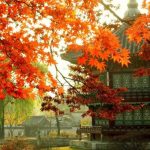
- OVERALL RISK: LOW
- TRANSPORT & TAXIS RISK: MEDIUM
- PICKPOCKETS RISK: MEDIUM
- NATURAL DISASTERS RISK: HIGH
- MUGGING RISK: LOW
- TERRORISM RISK: LOW
- SCAMS RISK: MEDIUM
- WOMEN TRAVELERS RISK: LOW
Frequently Asked Questions
How large is South Korea?
South Korea spans 38502.11 square miles in area, making it a bit smaller than Pennsylvania and a little larger than Indiana.
What are the biggest threats to Hwaseong Fortress?
Due to the use of wood construction materials, a fire could quickly destroy the fortress.
Moreover, weeds could topple the walls, and traffic vibrations could weaken the stone walls and gates.
When was Geumjeongsanseong Fortress erected?
Nearly 11 miles long and a little over five to ten feet high — the largest fortress in Korea — historians believe Geumjeongsanseong Fortress was built during the Three Kingdoms Era.
Who ordered the building of the Gyeonghuigung Palace?
King Gwanghae, the fifteenth king of the Joseon Dynasty, ordered the castle’s construction, which builders completed in 1623.
The Seoul Museum of History and the Seoul Museum of Art’s Gyeonghuigung Annex now share the palace grounds.
What did Changgyeonggung Palace become after the Japanese takeover?
Destroyed several times, most recently in the 1900s, it became a zoo and botanical garden under Japanese occupation.
Although the zoo moved to Seoul Grand Park, the botanical garden remains within the palace grounds.
What does Deoksugung mean?
The name Deoksugung means Palace of Virtuous Longevity.
This palace initially served as a temporary residence for Yi Jeong, Grand Prince Wolsan, an older brother of King Seongjong, the ninth monarch of the Joseon Dynasty.
How many Royal Palaces exist in South Korea versus the number of fortresses?
South Korea has five Royal Palaces.
However, it also has 2400 mountain fortresses throughout the country, including 212 mountain fortresses in Chungcheongbuk-do alone.
Why is Biwon, the Secret Garden of Changdeokgung Palace, so ecologically important?
Biwon holds more than 56,000 specimens of trees and plants, including zelkova (Zelkova errata), plum, hornbeam (Carpinus turczaninovii), yew, ginkgo, and pine.
What design principles did Master Doseon use to build Changdeokgung Palace?
The Buddhist monk, Master Doseon, used principles of bibo-pungsu-jiri, Korea’s version of feng shui, to ensure that the palace and its outbuildings harmonized with the landscape.
Why did civil engineers build the stream named Cheonggyecheon (청계천)?
They made Cheonggyecheon (청계천) during the Joseon era to provide a drainage system for the palace grounds.
The stream’s original name, Gaecheon (개천), means Opening of Heaven.
When did King Taejo build Gyeongbokgung Palace, whose name means Brilliant Fortune?
The founder of the Joseon Dynasty, King Taejo (태조), built Gyeongbokgung Palace in 1395 to house the royal family and serve as the center of government.
